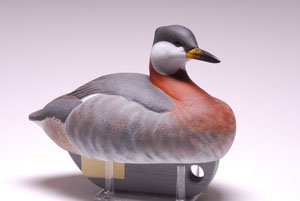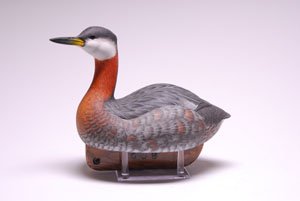|
Across Divisions
|
by Bill Einsig
|
|
Thanks to Don McHugh who helped sort through entries at Core Sound to find greenwings in most divisions. Also thanks to the following carvers who created the pieces in this article: Mark Strucko, Karen Lynn Hess, Don McHugh, Tom Christie, Gary Doviak, James Lewis, Jerry Barkley, Bob Polini, Joshua Rose, Heck Rice, Robbie Robertson, Greg Sorrell, and Gary Joe Bryan.
|
|
For most noncarvers attending carving competitions, the rows of decoys and decorative carvings arrayed for judging create a bewildering scene.
Not quite sure of the most basic divisions and categories, most visitors simply pass by the competition portion of the show, and move on to the vendor and artist tables where they can see and touch the pieces they like. The competition itself is just too mysterious.
Even after learning how the competition consists of a series of mini-competitions, called divisions, the visitor is at a loss in determining why one bird is in one division while another bird of the same species is placed in a different division. The obvious question is, "What is it that determines the division of each carving?"
Actually, that question, and a few related ones, led to the formation of the International Wildfowl Carvers Association (IWCA) more than twenty years ago. Carving competitions were very popular in the 1980s, but each competition operated with its own set of rules. What was called a working decoy in one show might have subtle differences in the working decoy division of another show. In one show, a miniature had to be 50% life-size, in another it had to be less than 80% life-size. The winner at one show could be disqualified in the next.
So, IWCA, really a very democratic association of clubs who meet, promulgate, and vote on rule adoptions and changes, set about designing a set of common rules to which all member clubs would agree to adhere for those specific divisions.
The present day advantage to individual carvers is that they can submit the same carving to all member shows and know their work will meet the rules established by that club through IWCA. If they submit their work to a show that is not a member of IWCA, it is the carver's responsibility to study the rules of that show, in advance, to be certain their work is qualified. Caveat emptor.
This arrangement also benefits member shows. By offering divisions with common IWCA rules, a show can expect to get more entries from IWCA carvers because the carvers can be certain of those common rules.
Today, IWCA-affiliated shows choose a slate of divisions for their schedule of competitions. Some of these are local divisions promulgated by their club, or guild, while others are divisions based on accepted IWCA rules and guidelines. Shows are expected to clearly identify whether local rules or IWCA rules apply for each division on the entry form and in promotional literature for the event.
Over the past twenty years, IWCA-affiliated clubs have agreed on rules for these seven wildfowl divisions.
- IWCA Working Decoy
- IWCA Canvas Decoy
- IWCA Style Decoy
- IWCA Style Shorebird Decoy
- IWCA Decorative Life-size Floating
- IWCA Decorative Life-size Nonfloating
- IWCA Decorative Miniature
So, with that background to the history of IWCA divisions, our most important question still remains. "What determines which carving belongs in which division?" "Why is one mallard a working decoy and another is an IWCA Style decoy?"
Let's take a closer look at each division and look for specific characteristics that determine placement in that division. First, however, there are two observations we need to make about this list of divisions.
First, notice the list is divided into four "decoy" divisions and three "decorative" divisions. Carvings in the decoy divisions have their origins embedded deeply in the hunting decoy tradition. To varying extents, these carvings must hold true to their hunting heritage and certain elements of judging recall decoy characteristics required for work in the field.
Carvings in the decorative divisions have no such ties to the hunting decoy tradition. In fact, many of these are carvings of species that have never been hunted. Rather, their roots stem from the natural beauty, grace, and personality of that species and, perhaps, its ecosystem.
The second observation is that one of the above divisions includes shorebirds. We're going to choose a species of waterfowl and track carvings of that species through six IWCA divisions. Because our sample bird is not a shorebird, we'll skip specific treatment of the IWCA Shorebird Decoy division.
The species we'll use in our discussion is the Green-winged Teal. Most of these carvings were entered in various divisions at the Core Sound Decoy Festival in 2008. We won't identify the carvers although we do appreciate using their work in this article. In addition, we're not looking at the quality of each carving. We plan only to look at the features that place it in the appropriate division. We'll begin with the basic hunting, or working, decoy and work through the decorative divisions.
We'll also list the carving and painting rules for each division and refer to them as we discuss each carving. If you'd like to see complete rules for that division, click the link and you'll bounce to our official rules page. Just click the return arrow on your browser to come back to this page.
|
|
IWCA Working Decoy
|
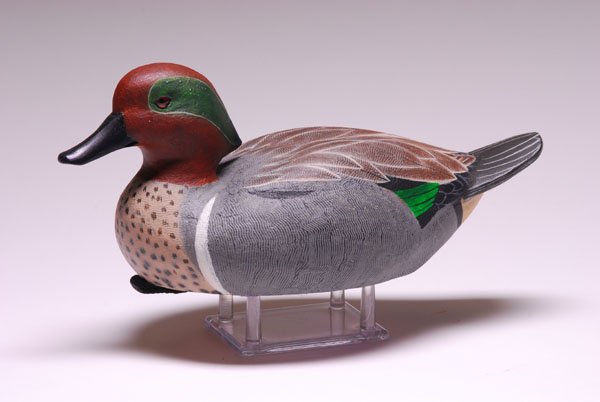 |
|
Working decoys are meant to be used as hunting decoys. They have to be durable to withstand prolonged, frequent use in the field. Carving and painting have to be similar to what traditional working birds would have. Nothing fancy. Just get it done and in the water to attract the live birds. Obviously, these decoys must float, and they must self-right.
The bill is basic and has no carved detail. Feathers, including the primaries, are simply painted with no carved detail. The tail is a simple flat section with a rounded perimeter and basic feather outlines painted on.
This particular bird has a simple paint scheme that portrays the species but is a bit fancier than some. Judges have to decide if the paint is too fancy for this division.
Read through the rules that follow and notice how this carving meets each rule. Also, notice that all the rules stress a functional, practical, durable, productive working decoy.
Carving and painting rules for IWCA Working Decoys
9.6 Decoys must be made by the carver and may be made of any carving material or stretched canvas.
9.7 Decoys will be judged for simplicity, durability, and practicality.
9.9 No detailed bills, carved nostrils or nails are allowed.
9.10 Slight mandible separation is permitted.
9.11 No fragile parts
9.12 Primaries may be undercut as long as they are not fragile.
9.13 Painting schemes must be simplistic.
9.14 Combing, stippling, brushing, ragging, scratching, blending, and use of burnt cork are allowed.
9.15 No feather splits or definitions other than outlining may be used.
9.16 No wood burning or stoning.
9.17 Texturing by means of paint or paste is allowed.
9.18 Decoys must have a facility for an anchor line.
9.21 Working decoys will be judged in hand (at the tank) for sturdy construction, durability, practicality of keel and ballast weights, anchor line attachments, self-righting, and flotation. Decoys that do not pass minimum structural and/or flotation requirements will be disqualified at this time.
|
|
Read all rules for IWCA Working Decoys
|
|
The following carvings are all working decoys. Notice how they meet the basic requirements of the division even though the carver has interpreted the species differently in each case.
|
| |
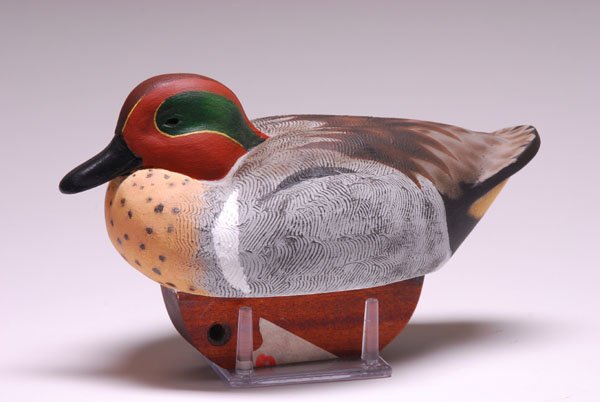 |
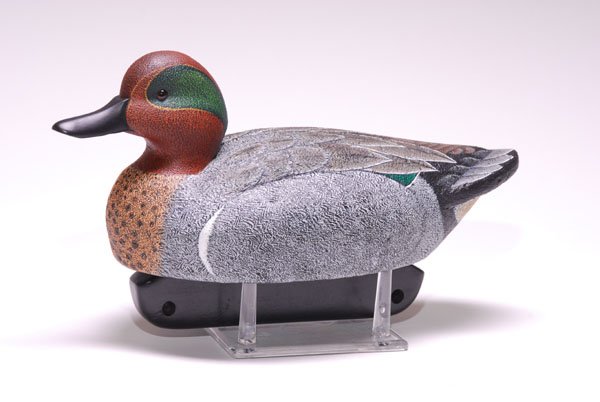 |
|
| IWCA Canvas Decoy |
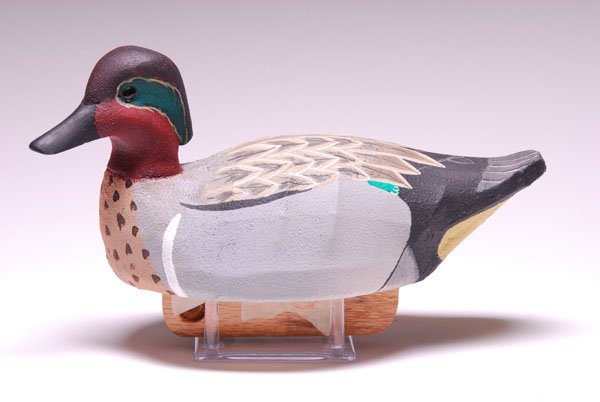 |
|
Everything said for working decoys can be repeated for canvas decoys. These are also true working decoys and must have the practical, durable, and functional characteristics. The difference is that while canvas decoys may have a carved wooden head, their body is a wire framework covered with canvas or other material. This results in a lightweight decoy many hunters prefer.
Again, review the rules for canvas decoys and notice their similarity to those for working decoys above. Does this bird meet all the rules?
Carving and painting rules for IWCA Canvas Decoys
10.6 Entries must be durable in construction and able to hold up under hunting conditions. Provision for anchor line attachment is required.
10.10 Painting will be simple in style. Combing, stippling, brushing, ragging, scratching, or blending is allowed.
10.11 Texturing by means of paint or paste is allowed.
10.12 Eyes are optional.
10.13 No detailed bills, carved nostrils, or nails allowed. Slight mandible separation is allowed.
10.14 No fragile parts allowed.
10.15 The body, excluding the bottom, must be completely covered with canvas or other material. The tail on Pintails and Long-tailed Ducks only may be left uncovered.
10.17 Workmanship is a major factor in this division, e.g., tight material covering with as few seams as possible.
|
|
Read all rules for IWCA Canvas Decoys
|
|
Here is another teal from the canvas decoy division. This one is covered with a burlap material stretched over a solid body. Notice the simplistic paint scheme compared to the working and canvas decoys we've seen so far. Remember, simple paint is good for working birds because hunter/carvers didn't want to spend much time producing fancy works of art that would be thrown in the water, bounced in the boat, and, perhaps, lost.
|
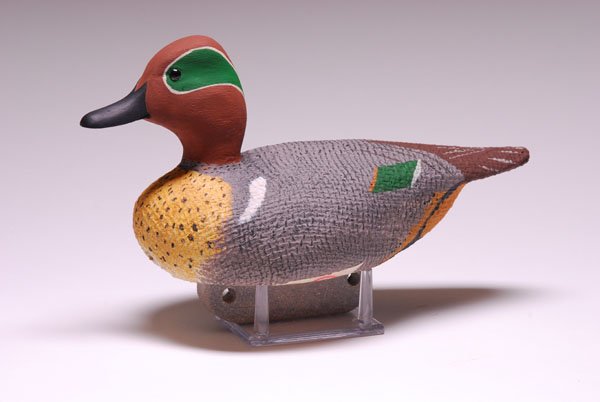 |
|
IWCA Style Decoy
|
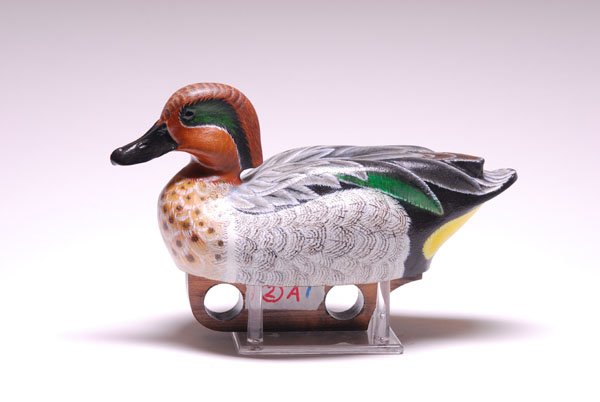 |
|
The IWCA Style Decoy division is often the most confusing for noncarvers and carvers alike. This division is really a blend of the working decoy we've seen earlier and the decorative birds to come. In a sense, it's a working decoy with a fancy paint job.
The decoy has to float and self-right as any good working decoy must. It has to be strong and durable like a working decoy, but some additional carving is allowed and there is no limitation on painting techniques.
The carver of the decoy above chose to keep the simple tail of a working bird but did add a bit of carved detail to the bill. Also, notice the primary feathers are slightly raised but have a firm, solid support under those feathers. When we look at the decoratives that follow, you'll notice a major difference in how the primaries are carved.
Remember, as we move through these divisions in this article, we're moving from limited carving and painting with the emphasis on practicality and durability to the decoratives where there are few, if any, limits on either carving or painting for life-like detail.
|
|
Carving and painting rules for IWCA Style Decoys
8.6 Decoys must be made of wood or cork.
8.8 Texturing will be allowed by rasping, chip carving, combing, scratching, and stippling.
8.9 No wood burning except as a cutting tool.
8.10 Stoning or carving (no burning) will be allowed on the crest, tuft, or hood of any species of waterfowl with a crest, tuft, or hood as long as it remains sturdy and functional.
8.11 Undercut areas, wingtips, tails, and necks must not be fragile.
8.12 Feather groups may be simply carved (back, side pockets, rump, and breast).
8.13 Only primaries, tertials, and tail feathers may be individually carved.
8.14 Carving under the bill is allowed.
8.15 Inserts may be used to strengthen weak areas such as bills, tails, and crests.
8.16 Primary feathers must be strong and well supported.
8.17 Feather splits may not be carved.
8.18 Decoys must have an anchor line attachment. Keels and weights are not required. Weight of decoy will be considered in the judging.
8.20 There will be no restrictions on painting of IWCA Style Division decoys. The carver is free to create expressive poses to capture the many attitudes of the waterfowl.
|
|
Read all rules for IWCA Style Decoys
|
|
The following photographs are poses of another decoy in the IWCA Style division. Notice the fancier paint than that of working birds, carved detail in the bill, and raised, but very solid, primaries. This carver also relieved the side pocket making it more distinct from the rump. You can see the change in contour at the rear of the side pocket, or just above the right-hand side of the Plexiglas stand. Also, notice how this carver painted feather splits over the back and tail.
|
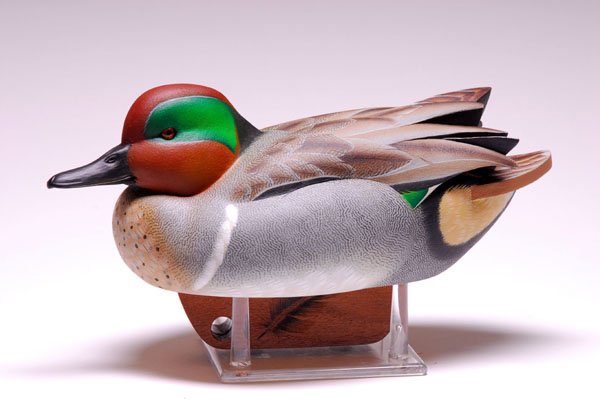 |
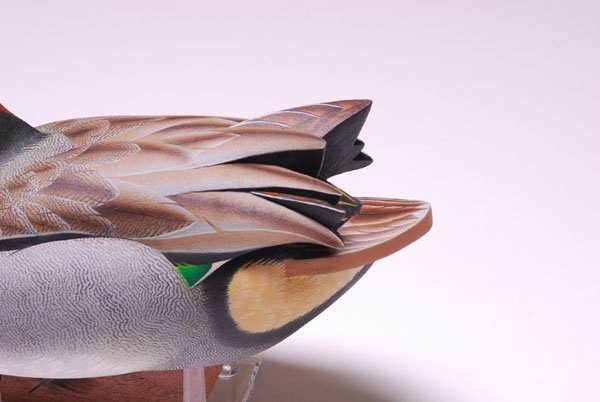 |
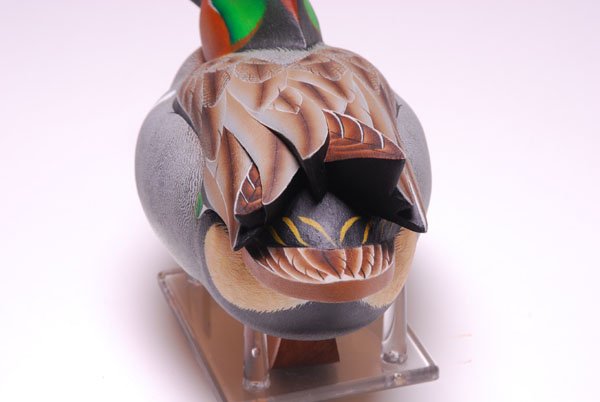 |
|
IWCA Decorative Life-size Floating
|
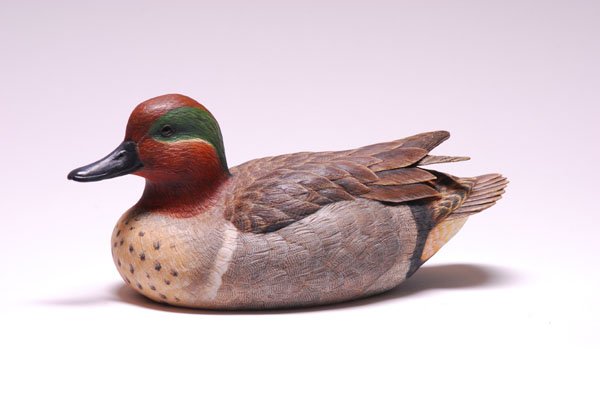 |
|
The teal in this division is much more detailed. There are no carving and painting limitations, so carvers are free to use almost any technique to capture the essence of the natural bird. Carvings in this division are expected to float naturally, but do not have to self-right.
Notice the detailed carving of the bill, tail, and body feathers. The primary feathers are raised and undercut into thin natural-looking feathers. Durability and practicality are not important considerations as they were in the decoy divisions.
Carving and painting rules for IWCA Decorative Life-size Floating
12.4 In addition to specific qualifications listed below, judges will evaluate carvings for craftsmanship, accuracy, essence of the species, and artistry as described in Section 4, IWCA Judging Criteria.
12.5 The entry will be judged in the tank from the waterline up using the live bird as a model.
12.6 They must float with life-like attitude, but do not have to self-right.
|
|
Read all rules for IWCA Decorative Life-size Floating
|
|
Here are more photos of carvings in this division.
|
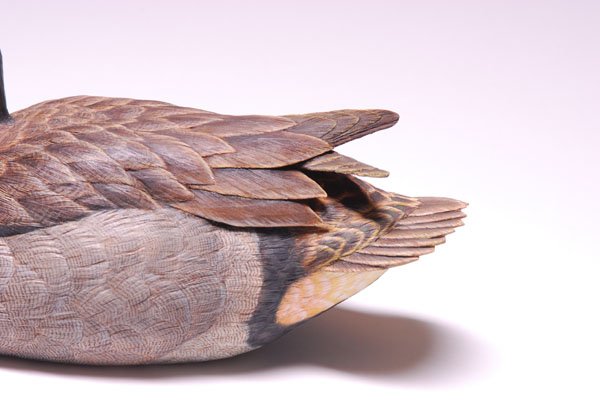 |
|
Notice the carved detail in all feathers.
|
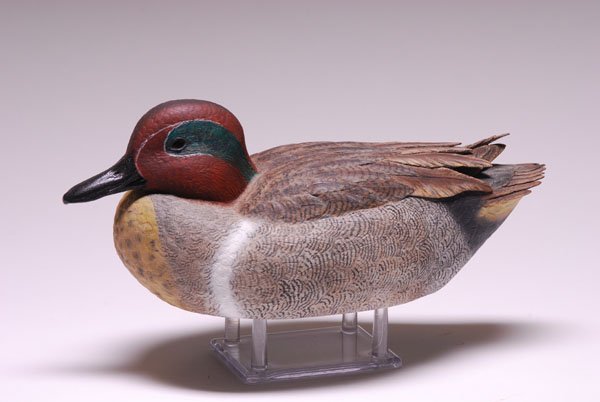 |
|
IWCA Decorative Life-size Nonfloating
|
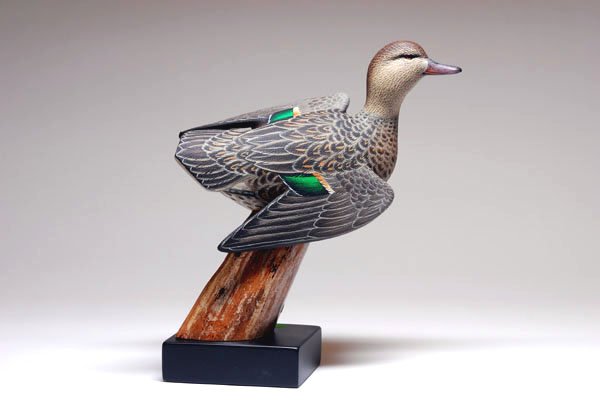
Photographed at 2008 Cal Open.
|
|
Carvings in this division are full-sized but not intended to float in water. All species of birds are appropriate subjects for this division.
There are no carving or painting limitations for this division, and artists may use all techniques to depict the live bird often in poses and motion appropriate to the species.
Carving and painting rules for IWCA Decorative Life-size Nonfloating
13.5 Must be full-bodied except when part of an environmental composition.
13.6 Feet and legs must be hand carved or constructed by the carver in Open level only.
|
|
Read all rules for IWCA Decorative Life-size Nonfloating
|
|
IWCA Decorative Miniature
|
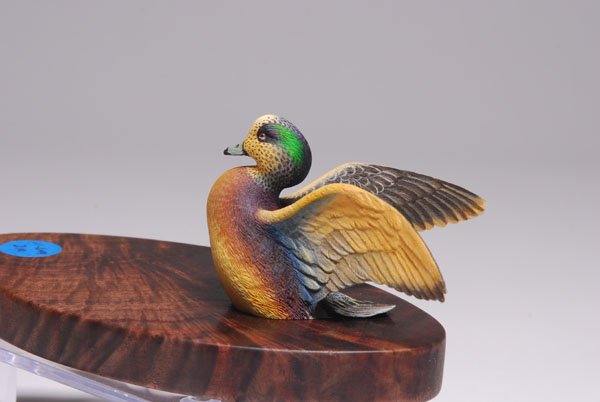
Photographed at 2008 Cal Open.
|
|
Decorative miniatures have no limitations on use of carving and painting techniques. They must, however, meet certain size criteria so that it's usually obvious where these carvings belong.
These carvings pose special difficulties for the carver but offer a wide range of creative, artistic effects.
Carving and painting rules for IWCA Decorative Miniatures
14.5 All birds must be one-half life-size or less, with a maximum subject length of eight inches from the tip of the bill to the tip of the tail.
14.6 The carving's length cannot exceed eight inches measured from the tip of the bill to the end of the tail.
14.7 Entries must be full-bodied except when part of an environmental composition.
|
|
Read all rules for IWCA Decorative Miniatures
|
|
More decorative miniature teal, in decoy style, from the 2008 Core Sound Decoy Festival.
|
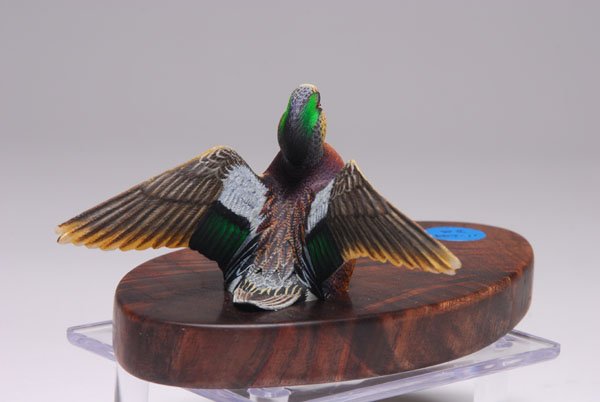
Photographed at 2008 Cal Open.
|
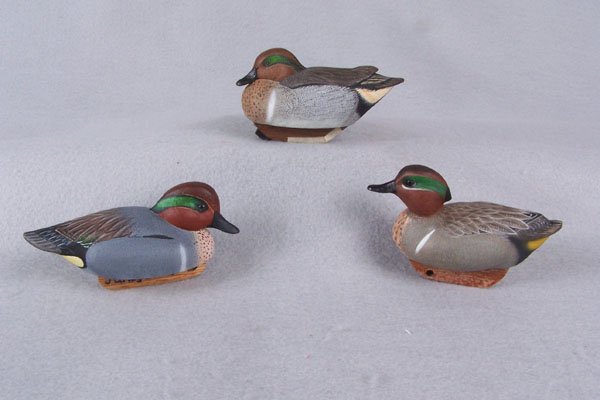
Photographed by Tom Johnson at the 2008 East Carolina Wildlife Arts Festival.
|
|
